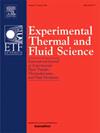New insights into wax deposition challenges: Experimental investigation across varied pipeline curvatures
IF 2.8
2区 工程技术
Q2 ENGINEERING, MECHANICAL
Experimental Thermal and Fluid Science
Pub Date : 2024-12-26
DOI:10.1016/j.expthermflusci.2024.111400
引用次数: 0
Abstract
This study investigates the intricate phenomenon of wax deposition in oil pipelines, with a primary focus on enhancing the understanding of wax deposition mechanisms. Special attention is given to the role of pipe curvature in influencing these deposition processes, exploring how bends in pipeline structures may alter the behaviour of wax deposition, potentially leading to operational challenges. A novel flow rig was designed and commissioned to simulate wax deposition in straight pipes and pipes with 45° and 90° bends at both horizontal and inclined positions. The objective of the work is to quantify the impact of flow parameters, such as the temperature and flow rate, on wax buildup under different pipe configurations. The results demonstrate that the temperature and flow rate are critical factors influencing wax deposition processes. Specifically, lower temperatures (ranging from 10 °C to 30 °C) and laminar flow conditions (Re < 2000) significantly aggravate wax deposition. It was found that pipe curvature plays a crucial role in the severity of wax buildup. For instance, the pipes with 45° and 90° bends exhibited deposition rates up to 8 % and 10 % higher than those observed in straight pipes, under the same flow conditions. These findings highlight the importance of incorporating pipe curvature effects into wax deposition models, especially in pipelines with complex geometries. This study provides new insights into enhancing the accuracy of predictive models for wax deposition. It highlights the importance of incorporating additional mechanisms, such as Brownian diffusion and gravity settling, in conjunction with traditional factors like molecular diffusion and shear dispersion.
蜡沉积挑战的新见解:不同管道曲率的实验研究
本研究旨在探讨石油管道中蜡沉积的复杂现象,以加强对蜡沉积机制的理解。特别关注管道曲率在影响这些沉积过程中的作用,探索管道结构的弯曲如何改变蜡沉积的行为,从而可能导致操作挑战。设计并调试了一种新型流动钻机,用于模拟直管、45°弯管和90°弯管在水平和倾斜位置的蜡沉积。这项工作的目的是量化流动参数,如温度和流速,对不同管道配置下蜡堆积的影响。结果表明,温度和流速是影响蜡沉积过程的关键因素。具体来说,较低的温度(范围从10°C到30°C)和层流条件(Re <;2000)明显加重蜡沉积。研究发现,管道曲率对蜡堆积的严重程度起着至关重要的作用。例如,在相同流量条件下,45°和90°弯管的沉积速率分别比直管高8%和10%。这些发现强调了将管道曲率效应纳入蜡沉积模型的重要性,特别是在具有复杂几何形状的管道中。本研究为提高蜡沉积预测模型的准确性提供了新的见解。它强调了将其他机制(如布朗扩散和重力沉降)与传统因素(如分子扩散和剪切分散)结合起来的重要性。
本文章由计算机程序翻译,如有差异,请以英文原文为准。
求助全文
约1分钟内获得全文
求助全文
来源期刊

Experimental Thermal and Fluid Science
工程技术-工程:机械
CiteScore
6.70
自引率
3.10%
发文量
159
审稿时长
34 days
期刊介绍:
Experimental Thermal and Fluid Science provides a forum for research emphasizing experimental work that enhances fundamental understanding of heat transfer, thermodynamics, and fluid mechanics. In addition to the principal areas of research, the journal covers research results in related fields, including combined heat and mass transfer, flows with phase transition, micro- and nano-scale systems, multiphase flow, combustion, radiative transfer, porous media, cryogenics, turbulence, and novel experimental techniques.
 求助内容:
求助内容: 应助结果提醒方式:
应助结果提醒方式:


